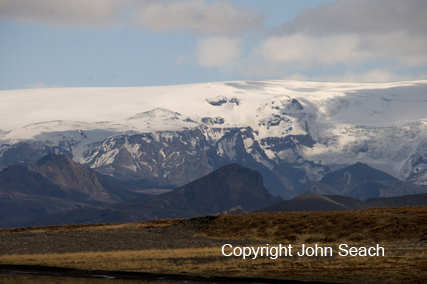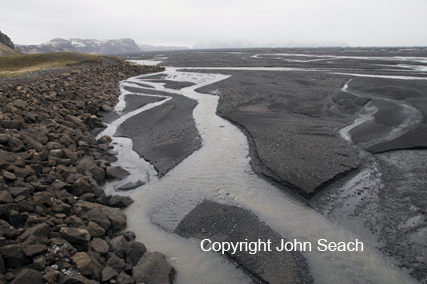Volcano Live
volcanolive.com
Katla Volcano | John Seach

Iceland
63.63 N, 19.05 W
summit elevation 1512 m
subglacial volcano
Katla Volcano is located in southern Iceland under Mýrdalsjökull glacier. It is considered the most dangerous volcano in Iceland.
The highest points of the ice cap lie on the caldera rim and include Goðabunga, Háabunga, Austmannsbunga, Enta, Entukollar.

Katla Volcano, Iceland - John Seach

Myrdalssandur, drainage for Katla Volcano - John Seach
Eruptions at Katla volcano are phreatomagmatic, and produce high eruption columns and catastrophic meltwater floods. Historically large eruptions have occurred at regular intervals about every 50 years.
Holocene eruptions at Katla volcano have been characterised by three types.
1) Basaltic explosive eruptions inside the caldera have occurred twice per century.
2) Silicic explosive eruptions in or near the caldera occur less frequently.
3) Large effusive basaltic fissure eruptions, producing volumes of 10 cubic km have occurred on two occasions during the Holocene.
Earthquakes at Katla Volcano
Katla has been seismically active for at least the past forty years, with two distinct areas predominating - Gooabunga rise in the west, and within Katla caldera in the centre. Earthquakes are more common during the autumn than during spring. There is almost no seismicity at the beginning of the year, and the earthquakes start to
occur in late summer. Seismicity indicates an intruding hot and acidic cryptodome, with a summit at a depth of 1.5 km.
2011 Activity
An earthquake swarm began under the Mýrdalsjökull glacier in Iceland near Katla volcano. The swarm began around 3 am on 5th October 2011. The first earthquake in the swarm measured magnitude 3. Residents of Vík in on the coast near the glacier were alerted to a possible glacial outburst from Mýrdalsjökull.
An eruption possibly started at Katla volcano, Iceland on 9th July 2011. A glacial flood, possibly from an eruption of Katla volcano under the Mýrdalsjökull icecap damaged Highway number 1 by the river Múlakvísl. The bridge across Múlakvísl has was damaged and the road closed between Höfdabrekka, east of Vík, and Skálm River, near Álftaver.
10th July 2011 update
Activity has decreased significantly under Mýrdalsjökull glacier in Iceland after the glacial burst which destroyed a bridge and part of highway number 1. Seismic activity has returned to normal levels. The flood in Múlakvísl has decreased, and the water level in the river has returned to normal. The Civil Protection Department has lowered the alert level from danger to uncertainty. The road is closed between Höfðabrekka, east of Vík village, and river Skálm, near Álftaver, and the river will be impassable for at least 2-3 weeks. Currently the only road past the area is the highland road Fjallabaksleid nyrdri, which is only passable for 4x4 vehicles. Evacuation order for Álftaver and Meðalland areas has been cancelled and people have returned home. Mýrdalsjökull glacier is still considered dangerous and is closed to the public. The glacial outburst was possibly caused by a small subglacial eruption of Katla volcano. Scientists flew over the eruption site yesterday and observed two 50 m deep depressions at the site where the glacial burst occurred. The walls of the depression shows layers of ash from the eruption of Eyjafjallajökull last year, and the recent Grímsvötn eruption. The depressions contain vertical walls which indicate that the glacial melt occurred very quickly. It was caused either by a magma or a steam explosion. There are deep and wide cracks around the depressions.
23 May 2010 Update
In the past 48 hours 3 earthquakes occurred at Katla volcano, Iceland. The earthquakes may be due to ice movements within Mýrdalsjökull glacier or magma movement under the volcano. Scientists have been keeping a close watch on Katla volcano, due to the possibility of an eruption triggered by the activity at nearby Eyjafjallajokull.
1999 Eruption
In 1999 there was a glacial outburst at Katla volcano, possibly caused by a small eruption under the ice. The water flowed into Jökulsá á Sólheimasandi river. The source of the melting was a depression formed in the glacier surface. The flood was preceded by a burst of seismic tremor. Subglacial geothermal activity increased in the following weeks. Geothermal activity at Katla increased since 1999.
934 AD Eruption
A great basalt fissure eruption
known as Eldgjá (Fire Chasm) occurred at Katla volcano in 934 AD. This eruption was one of the two largest terrestrial fissure eruptions of the last 11
centuries.
Further reading
Schmith, J., Höskuldsson, Á., Holm, P.M. and Larsen, G., 2018. Large explosive basaltic eruptions at Katla volcano, Iceland: Fragmentation, grain size and eruption dynamics. Journal of Volcanology and Geothermal Research, 354, pp.140-152.
Óladóttir, B.A., Sigmarsson, O., Larsen, G. and Thordarson, T., 2008. Katla volcano, Iceland: magma composition, dynamics and eruption frequency as recorded by Holocene tephra layers. Bulletin of Volcanology, 70(4), pp.475-493.
Gudmundsson, O., Brandsdóttir, B., Menke, W. and Sigvaldason, G.E., 1994. The crustal magma chamber of the Katla volcano in south Iceland revealed by 2-D seismic undershooting. Geophysical Journal International, 119(1), pp.277-296.
Katla Volcano Eruptions
2011?, 1999, 1955, 1918, 1860, 1823, 1755-56, 1721, 1660-61, 1625, 1612, 1580, 1450 ± 50 yr, 1440, 1416, 1357 ± 3, 1311, 1262, 1245, 1177 ± 2, 1150 ± 50, 934 AD ± 2, 920 AD, 270 AD ± 12, 850 BC ± 50, 1220 BC ± 12, 1450 BC ± 40,